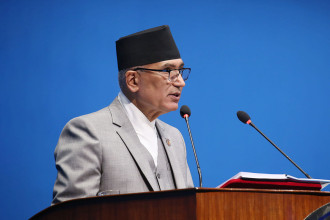-1752225714.jpg)
Faced with a significant surplus of loanable funds in banks and financial institutions (BFIs) and sluggish credit demand, Nepal Rastra Bank introduced its 24th Monetary Policy on July 11. This policy aims to boost aggregate demand and stimulate economic growth. The first Monetary Policy under the new Governor, Dr Biswo Nath Poudel, projects a 12% growth in private sector credit and a 13% increase in broad money supply. While the estimated private sector credit mobilisation is expected to help achieve the government’s 6% growth target, it could potentially exceed the monetary policy’s inflation target of below 5%.
A key highlight of the new monetary policy is the permission to include non-banking assets (NBA) in the capital fund. This provision will enhance banks’ lending capacity by addressing solvency issues. Despite BFIs holding over Rs 700 billion in loanable funds, some have been unable to extend further credit due to solvency concerns. Additionally, banks are currently struggling with rising non-performing assets and a significant increase in blacklisted borrowers in recent years, complicating recovery efforts.
Overall, the monetary policy is largely accommodative and designed to spur economic growth. Its flexible provisions are anticipated to boost confidence within the private sector which had previously adopted a ‘wait and watch’ approach to credit due to stringent past monetary policy compliance. While the previous year’s monetary policy was largely flexible, working capital guidelines reportedly discouraged private sector borrowing. The new governor, immediately upon his appointment, deferred these guidelines for two years. The new policy also announced the introduction of sector-specific working capital guidelines for the health, education, media, agriculture and MSME sectors, recognising their unique operational and credit-repayment cycles.
During the release of the FY 2025/26 Monetary Policy, Nepal Rastra Bank Governor Dr Poudel highlighted the country’s opportunity to leverage abundant loanable funds and lower credit rates. He stated, “Given the low inflation and comfortable foreign exchange reserves, NRB has formulated a cautiously flexible monetary policy.” The governor emphasised that this approach would help the economy gain momentum through private sector capital formation and reduced costs for the government’s domestic debt mobilisation.
However, experts have expressed concerns that the new monetary policy lacks innovative solutions to significantly advance the economy or bolster financial sector stability. Nara Bahadur Thapa, former Executive Director of Nepal Rastra Bank, commented, “It simply revolves around the status quo rather than orienting towards unconventional solutions.” Thapa criticised the policy’s continued reliance on sectors like real estate, automobiles and the share market to drive economic growth, believing these sectors have limited optimisation potential and have ‘already reached a dead end’. He further noted the policy’s oversight of the burgeoning ICT sector, high-value/low-volume agricultural products, and manufacturing (based on vertical specialisation).
Financial sector analyst, Shovan Dev Pant, pointed out the policy’s one-sided focus on facilitating borrowers, arguing it fails to address depositor protection. “It is incomplete due to the absence of a balancing approach towards depositors and borrowers,” Pant stated, suggesting that without this balance, the monetary policy’s objectives might not be achieved.
Major amendments
The monetary policy has adjusted the standing liquidity facility (SLF) rate, the upper ceiling, from 6.5% to 6%. Concurrently, the standing deposit facility (SDF) rate, the lower ceiling, has been revised from 3% to 2.75%. The policy rate (14-day repo rate), which serves as the operating target within the interest rate corridor, has also been lowered from 5% to 4.5%. Furthermore, the central bank plans to issue NRB Bonds to address structural liquidity challenges within banks and financial institutions.
The Monetary Policy 2025/26 prioritises credit access for
restaurants/hospitality and industry/businesses located along the Mid-Hill and Postal Highways. Credits up to Rs 30 million will now be classified under the SME credit category, with interest rates capped at base rate plus two percentage points. Additionally, earthquake victims in Jajarkot and Rukum districts are now permitted to reschedule and restructure their loans by paying only 10% of the total accrued interest until the current period. The policy also announced a review of interest capitalisation for credit extended to the energy sector.
With the implementation of the new monetary policy, farmers can secure loans of up to Rs one million against crop collateral, benefiting from minimal loan loss provisioning during the grace period. Moreover, other credit types, primarily term loans, can now be aligned against collateral such as cereals, crops, livestock and fisheries. The monetary policy has also extended loan restructuring and rescheduling facilities to land development firms officially registered with government agencies.
Advancements in digital banking and payments
Nepal has made significant progress in digital banking and payments with increasing acceptance and adoption across the country. Building on this momentum, the monetary policy has initiated a new strategy following a review of the National Payments System Development Strategy. This aims to bolster payment systems and introduce a ‘Regulatory Sandbox’ to foster innovation in digital payment systems, ensuring robust security standards.
Moreover, risk-based supervision will be implemented for Payment Service Providers (PSPs) and Payment System Operators (PSOs). The Digital Lending Guidelines will also be revised to facilitate digital lending specifically for micro, small and medium enterprises.
Challenges and opportunities
The monetary policy emphasises the necessity of establishing an Asset Management Company to tackle the persistent challenges of managing non-performing loans (NPLs) and non-banking assets. The unaudited financial statements from 20 commercial banks reveal a concerning trend: non-performing loans (NPLs) surged to 5.05% of their total loan portfolio (Rs 4,807.48 billion) by April 2025. This is a significant increase from just 1.5% in the 2022/23 fiscal year. This rise in NPLs negatively impacts banks’ ability to lend. Concurrently, the policy highlights the potential of leveraging the current abundance of loanable funds and low interest rates, along with harnessing skills, capacity and opportunities to adopt new technologies.
The monetary policy announces the development of a Domestic Systemically Important Bank (DSIB) Framework to impose additional regulatory and supervisory provisions on such banks. It also schedules an asset quality review for commercial banks, a process that was previously halted due to a court challenge against Nepal Rastra Bank’s decision to review the loan portfolios of the top 10 large banks.
Further, NRB underscored the revision of credit-to-deposit ratio related regulatory provisions following the full implementation of the Liquidity Coverage Ratio (LCR) and Net Stable Funding Ratio (NSFR), aiming to enhance stability by minimising liquidity risks. The central bank will also issue Guidelines on Internal Liquidity Adequacy Assessment Process (ILAAP) to bolster liquidity risk management. Henceforth, hire purchase companies will be subject to additional compliances, including fit and proper tests, and the calculation of credit rates and service fees.
Addressing FATF grey list status
Given Nepal’s placement on the Financial Action Task Force (FATF) grey list due to its inability to meet the 40 FATF recommendations, the Monetary Policy 2025/26 places significant emphasis on exiting this status. The policy states, “Effective coordination shall be made among concerned agencies for the implementation of set course of actions to come out of grey.” Specifically, concerns related to Nepal Rastra Bank will be addressed through inspection, investigation and recommended actions, including enhancing the effectiveness of investigations by granting full autonomy to the Financial Intelligence Unit.
Key highlights
Growth projections for private sector credit: 12%
Growth projections for broad money supply: 13%
Inflation: 5%
Cash reserve ratio: 4%
Statutory liquidity ratio: 12% for Class ‘A’ banks and 10% for Class ‘B’ and ‘C’ financial institutions
Upper and lower ceiling of the interest rate corridor (IRC): 6%-2.75%
Policy rate: 4.5%
Foreign exchange facility against visa and ticket: $3,000
Home loan limit: Rs 30 million
LTV for first home: 80%
Margin lending: Up to Rs 250 million
Agriculture loan against collateral of crops: Rs 1 million
Cap in bonus distribution of MFIs: No more than 15%
• Loan restructuring and rescheduling provisions for real-estate companies
• BFIs are allowed to invest in debentures issued by infrastructure development committee
• Categorised loans issued to migrant Nepalis (with or without collateral) under deprived sector lending: Rs 3 lakhs for male and Rs 5 lakhs for female
• Non-deliverable forwards (foreign exchange): up to 25 of Tier-1 capital
• Classification of remittance companies based on their capital and transaction amount
• Announcement of implementing credit score-based lending
Private sector applauds monetary policy
The private sector has lauded the new monetary policy, anticipating it will significantly boost the economy. The Confederation of Nepalese Industries (CNI), in a statement, particularly welcomed the revision of ‘Working Capital Guidelines’ based on payment-income cycles. CNI believes that facilitating credit mobilisation for businesses, real estate and the stock market will enhance investor confidence. According to CNI, “Credit scores are recognised as an important element to avail lending, and the BFIs shall lend analysing the knowledge, skills and capacities of borrowers abiding self-regulation, which might help us shifting towards innovative approaches in lending policies of BFIs from traditional fixed and movable assets-based collaterals.” CNI further stated that adequate credit flow to the private sector will contribute to achieving the government’s growth target, adding, “We hail the approach to take advantage from higher liquidity and low credit rates by mobilising credit to the private sector and cutting down the rates in government borrowing.”
The Confederation of Banks and Financial Institutions Nepal (CBFIN) also praised the monetary policy, highlighting its significant approaches towards promoting investments in productive, employment-generating, export-oriented and youth-focused sectors, as well as fostering inclusivity. CBFIN noted that the provision allowing the inclusion of non-banking assets in the capital fund has alleviated capital stress for BFIs and enhanced their lending capacity.
Conversely, some commodity associations have criticised the policy for omitting sector-specific recommendations and for inconsistencies in the loan-to-value (LTV) ratio. Nepal Automobile Importers and Manufacturers Association (NAIMA) asserted that an 80-20% LTV ratio should be uniformly maintained for all vehicle types, without distinction between electric vehicles (EVs) and internal combustion engine (ICE) vehicles. NAIMA further claimed that the monetary policy overlooked rational suggestions such as permitting the opening of Letters of Credit (LCs) in Chinese yuan for vehicles produced and shipped from China, and reducing the risk-weighted asset ratio on vehicle loans from 100% to 75%.




-1761806697.jpg)
-1758006240.jpg)
